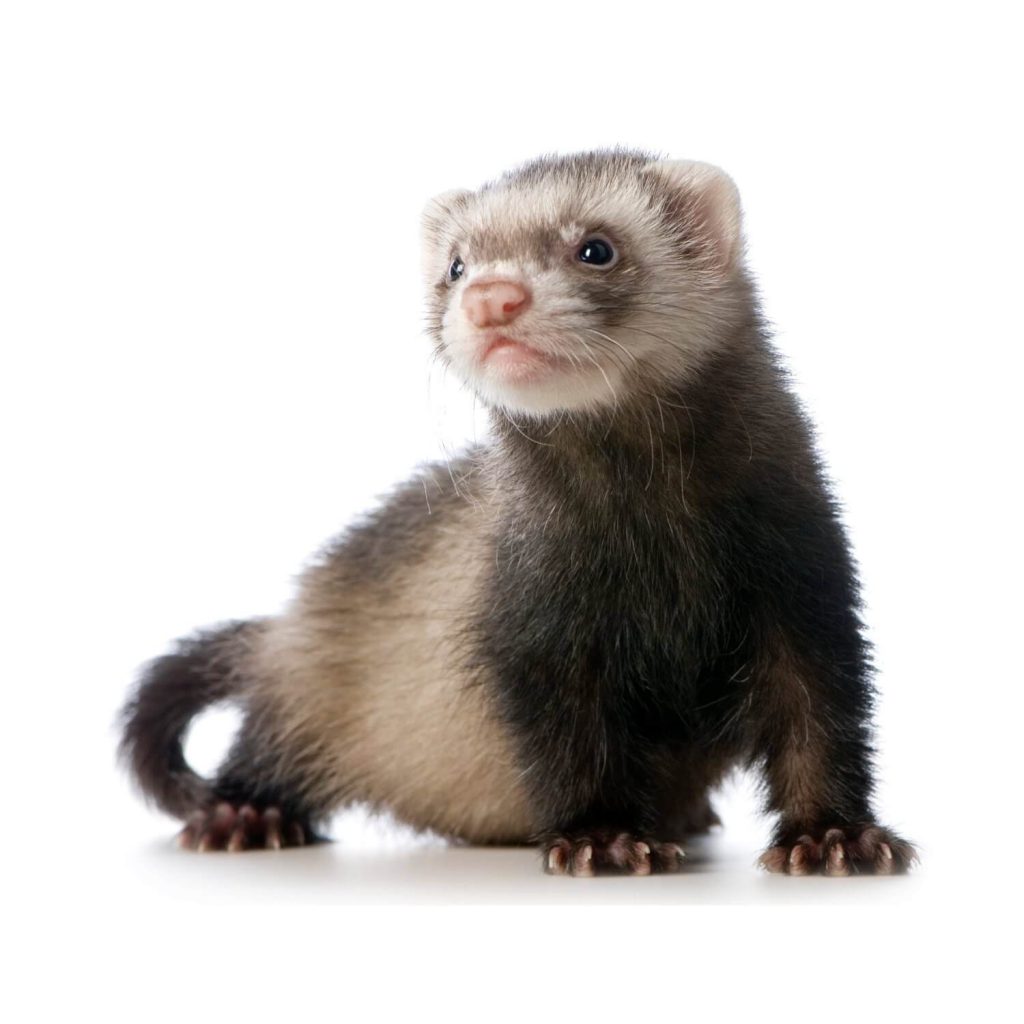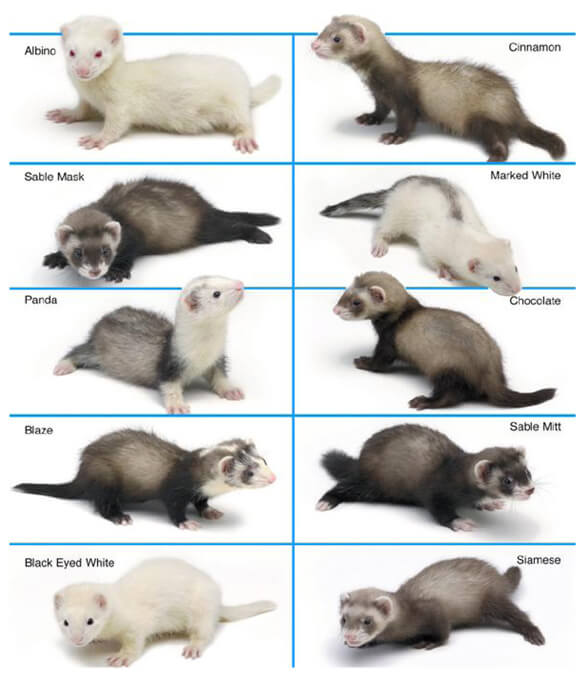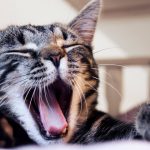Ferrets – Everything you need to know!
General Information
“The female ferret is called a jill, the male is a hob, and the infants are called kits.”
The ferret has been domesticated for over 2000 years. It was originally used for pest control and hunting in Europe (the polecat). They are members of the weasel family (Mustelidae), which includes skunks, otters, mink, weasels and badgers. Ferrets are generally good natured, inquisitive, playful animals that enjoy the company of humans.
Ferret coats have several different color patterns. The fitch or sable ferret is the most popular. Fitch ferrets have a buff colored coat with black markings on the face, feet, and tails. Albino ferrets are white with pink eyes. Some ferrets have a buff coat with light markings. Other types and color variations include the silver mitt, Siamese, cinnamon, panda, black-eyed white, blaze and butterscotch.

Pregnancy & Reproduction
The female ferret is called a Jill, the male is a hob, and the infants are called Kits.
The gestation period, or length of pregnancy, is about 42 days. Like puppies and kittens, kits are born deaf and with their eyes closed. They begin walking by about 3 weeks of age, which is also when their eyes and ears open. By about 6 weeks of age, they can be weaned onto ferret food. The average life span is 5-8 years; ferrets are considered geriatric pets at 3 – 4 years of age (compared to 7 – 8 years of age for dogs and cats).
Ferrets are usually spayed or neutered and de-scented prior to purchase. Unless you want to breed your prospective pet, surgical sterilization is highly recommended. Intact (un-neutered) male ferrets have a musky odor and can be more aggressive; once female ferrets reach sexual maturity, they will remain in estrus, or heat, unless bred. This prolonged heat results in bone marrow suppression from high levels of estrogen; unless treated early and aggressively this can cause death.
The anal sacs (or anal glands) of ferrets secrete a foul-smelling, musky liquid. De-scented ferrets (which have had these sacs removed) make more aesthetically appealing pets. Even after de-scenting, ferrets still have a slightly musky odor. You can routinely bathe your ferret weekly or every other week, using a gentle moisturizing shampoo as recommended by your veterinarian.
Good pets
Ferrets can make good pets. As with all animals, socialization is important. If not properly trained, they can be aggressive and nippy. Check with your veterinarian prior to purchasing a ferret if you have small children.
Ferrets are true carnivores. The best diet for a pet ferret is commercial ferret food. For further information, see our handout, Ferrets – Feeding.
Ferrets easily learn to use a litterbox.
“Due to their curious nature, ferrets are great escape artists.”
Due to their curious nature, ferrets are great escape artists. All holes, no matter how small, leading to inaccessible areas MUST be blocked off to prevent escape or injury. If the ferret can put his head into it, the body will fit too. They will burrow into the foam of couches, chairs, and mattresses, and climb into the back of stereo speakers, closets, and drawers. These areas should be blocked off or sealed off with thin plywood or hardware cloth.
Ferrets love to chew, so ALL FOAM, PLASTIC and RUBBER objects MUST be kept out of harm’s way, including shoe inserts, ear plugs, kid toys, pet toys, erasers, rubber bands, balloons, speaker foam, headphone foam, swim goggle liners, etc. If a ferret swallows one of these objects, it can cause a gastrointestinal obstruction (blockage), which may lead to an expensive surgery or perhaps cause its death.
“Some people recommended putting a collar with a bell attached on your ferret.”
Some people recommended putting a collar with a bell attached on your ferret, so that it can be easily found if it escapes your sight (make sure it’s firmly secured to the collar and can’t easily detach, and make sure that the bell can’t be swallowed if it does become detached).
Declawing
“Ferrets should not be declawed.”
Ferrets should have their sharp claws or toenails trimmed regularly. Your veterinarian can teach you how to do this procedure safely. Ferrets should not be declawed.
Vaccinations
Just like dogs and cats, ferrets require a series of vaccinations as youngsters. At least once a year, they also require an examination, a fecal test for internal parasites, and booster vaccinations. Once a ferret becomes 3 – 4 years of age, it requires a complete geriatric profile (see below).
Ferrets are usually vaccinated at 8, 12, and 16 weeks of age against canine distemper. There is also an approved vaccine for rabies in ferrets. However, since local municipal laws vary regarding ferret bites, some veterinarians do not vaccinate ferrets for rabies.
Other anatomic and physiologic features of ferrets
“Ferrets do not have any identifiable blood types.”
Ferrets do not have any identifiable blood types. Therefore, blood from any ferret can be given to a ferret that needs a blood transfusion.
Ferrets are very susceptible to hypoglycemia (low blood sugar). For this reason, they are only fasted for a few hours (rather than overnight) prior to surgery or blood sampling.
Ferrets, like many small mammals and pocket pets, are extremely susceptible to heat stress or stroke. The temperature must be kept below 90o F (32o C).
Selecting Your Pet Ferret
- In some municipalities, it is illegal to own a pet ferret, due to the potential for attacks on people (specifically young children, as ferrets can be aggressive and nippy) and due to the chance of escaped ferrets becoming established in the wild. If owning a ferret is legal in your area, they can be purchased at pet stores or through breeders or ferret club members.
- Ideally, purchase a young ferret, since it will adapt more readily to its new home.
- The eyes and nose should be clear and free of any discharge that might indicate distemper or a respiratory infection.
- The ferret should be curious and inquisitive; it should not be thin or emaciated.
- Check for the presence of wetness around the anus, which might indicate diarrhea.
- Check for the presence of external parasites such as fleas.
- If possible, examine the ferret’s mouth for broken teeth, discolored gums (they should be light pink), or any obvious sores around the mouth, any of which could suggest disease.
- Inquire as to whether the ferret has been surgically altered (spayed or neutered) and de-scented (had its anal sacs surgically removed); most ferrets have these operations performed by 8-12 weeks of age, prior to purchase.

The First Veterinary Visit
“Your ferret should be examined by a veterinarian who treats these special pets within 48 hours of purchase.”
Your ferret should be examined by a veterinarian who treats these special pets within 48 hours of purchase (this is often required by the seller or the guarantee is voided). At this visit, your veterinarian will discuss proper diet, housing, and toys for the ferret. A vaccination program will be set up, a fecal sample will be checked for worms or other intestinal parasites, and the ferret may be started on heartworm preventative. Like dogs and cats, ferrets require annual veterinary visits.
Once a ferret reaches 3 years of age, a complete geriatric work-up, which includes an EKG, urinalysis, blood tests and radiographs (X-rays), is necessary on at least an annual basis. This will allow for the early detection of diseases so commonly seen in older ferrets, such as cardiomyopathy and cancer.


